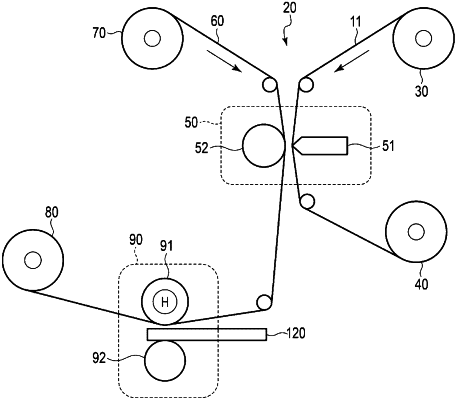| CPC B41J 35/36 (2013.01) [B41J 33/54 (2013.01); B41J 2203/01 (2020.08)] | 5 Claims |

|
1. An indirect transfer printer, comprising:
a primary transfer unit that primarily transfers an image from an ink ribbon to an indirect transfer film;
a secondary transfer unit that secondarily transfers the image from the indirect transfer film to a recording medium;
a primary transfer positioning sensor; and
a processor, wherein
an initializing operation of the indirect transfer printer includes in sequence:
detecting sensor marks transferred together with an image at a past primary transfer time by the primary transfer positioning sensor while the indirect transfer film is conveyed from a supply spool to a winding spool;
determining by the processor that the indirect transfer film has not been replaced before the initializing operation due to detection of the transferred sensor marks;
if it is determined that the indirect transfer film has not been replaced, estimating by the processor a remaining amount of the indirect transfer film based on a ratio in rotation angle between the supply spool and the winding spool measured by a rotary encoder from start to end of the conveyance;
if an unused amount is estimated to be equal to or greater than a remaining amount alert threshold, performing positioning of the primary transfer based on a last sensor mark among the sensor marks;
if the unused amount is estimated to be less than the remaining amount alert threshold, conveying the indirect transfer film by an image area as a lead from the last sensor mark and an image area as an error margin of rotation number of one wind; and
if an end mark indicating a final end of a usable region of the indirect transfer film is not detected by the primary transfer positioning sensor during the conveying, determining by the processor that the unused amount is greater than an amount necessary for recording on a next recording medium.
|